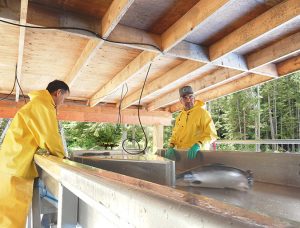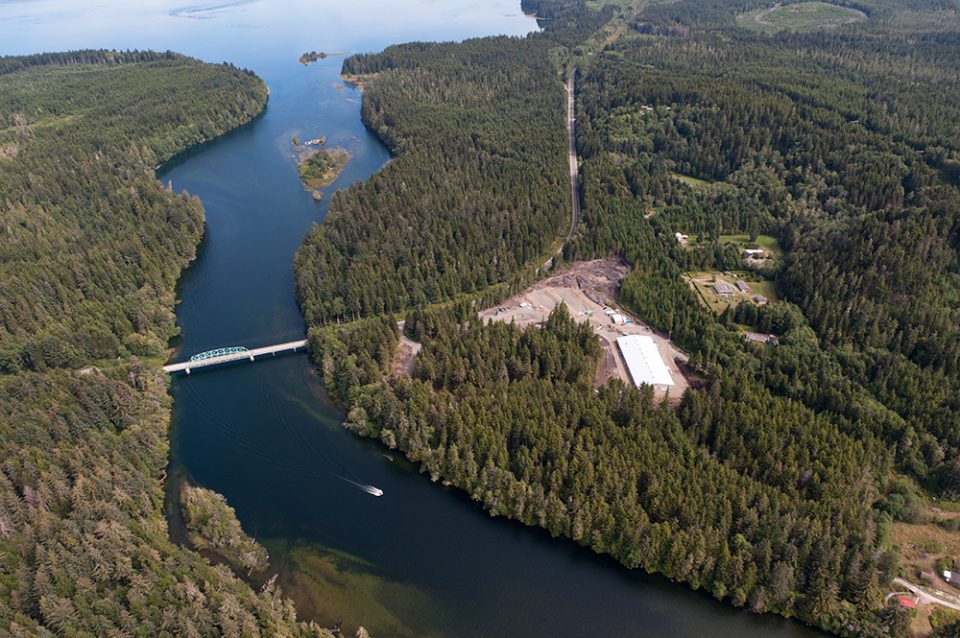Land-based systems play important roles for salmon aquaculture, but can RAS production ever catch up to net pens?

In 2010, the SOS (Save Our Salmon) Marine Conservation Foundation entered into a unique partnership with the ‘Namgis First Nation in British Columbia. Their goal? To plan, fund and construct Canada’s first land-based salmon farming operation. Construction of the $7.6 million facility broke ground in 2012 and by the next year some 23,000 Atlantic salmon smolts were growing in five, 500-cubic-meter enclosed tanks near the north end of Vancouver Island.
The result of this work is Kuterra, an RAS-based salmon farm that is fully owned by the ‘Namgis and one of only a handful of commercial-scale, land-based recirculating aquaculture systems (RAS) for salmon in the world. The Kuterra facility is capable of producing about 300 tons of salmon per year, growing smolts to maturity in 12 to 15 months.
“As sure as they grow tomatoes in greenhouses, they’re going to grow Atlantic salmon in giant tanks on land,” said Kuterra CEO Garry Ullstrom. “At least an increasing proportion of production will be out of land-based systems.”
In addition to the built-in advantages of land-based fish farming – disease prevention, better biological controls, pollution prevention, to name a few – these facilities are space and resource efficient, allowing them to be located in parts of the world where today fish would seem to be out of place.
Still, the growing industry faces challenges. RAS remains a tiny fraction of the overall salmon market, and the costs associated with creating and maintaining a profitable RAS business remain steep, even for the established players.
Case in point: Just this month, the ‘Namgis First Nation, owner of Kuterra, ordered the company to wind down operations. Now that the original startup funding has run out, Kuterra’s owners have struggled to keep the venture afloat, even as they sought buyers to invest in and expand the company. Operations continue at the facility as of this month, but the company’s long-term future remains very much in doubt.

Investors interested
Still, despite these business challenges, the shift to land has been a long time coming.
RAS use for salmon dates back to 1989, when scientists from The Freshwater Institute in Shepherdstown, W.V. (USA) first published research to prove that the technology could be a biologically, technically and economically feasible concept. RAS had previously been used for perch and other varieties of fish, which were grown on dry land in enclosed tanks that continuously clean and recirculate the water, but never before with large species like salmon. Development of the industry was slow to start, but has picked up in the last several years as both demand for salmon and the market potential has grown, attracting new investment to the sector.
I don’t see it replacing net pens at all, but I think it’s a way to expand salmon farming, especially in places that don’t have it.
“In the last five years we’ve had tremendous growth in the capability we have for grow-out of Atlantic salmon,” said Steve Summerfelt, Ph.D., director of aquaculture systems research with The Conservation Fund Freshwater Institute (TCFFI). “Right now there are over a dozen facilities that I know of that have salmon stocked or are marketing it.”
Total land-based salmon production worldwide is still a miniscule part of the seafood market – less than half of 1 percent of total production. But even at that level, it’s still significant, as is the fact that many of the investors that are flocking to the sector now are new to fish farming. According to a February 2017 report from Norwegian investment bank DNB Markets, annual land-based salmon production could reach 100,000 to 200,000 tons in the next 10 years if these investment trends hold up, putting the niche at 5 to 10 percent of total salmon production in that time.
“That would be a huge achievement,” Summerfelt said. “I don’t see it replacing net pens at all, but I think it’s a way to expand salmon farming, especially in places that don’t have it.”
Scale to succeed
Among the larger players in RAS salmon is Atlantic Sapphire with its 800-ton Langsand Laks facility in Denmark and the larger facility it is currently developing near Homestead, Fla., in partnership with Billund Aquaculture. That facility, which was cleared for construction by local officials this month, will produce 10,000 tons annually to start before ultimately ramping up to 90,000 tons of capacity.
The capacity for most of the RAS salmon farms being developed today are in the range of 2,000 to 5,000 tons.
Scale is important for land-based aquaculture, explains Atlantic Sapphire CEO Johan Andreassen, because it allows for economies of scale and lowers the per-ton cost of production.
“We think a minimum of 5,000 tons, ideally more like 5,000 to 8,000 tons of annual production, is where you need to be in order to be able to compete,” he said.
Most producers simply aren’t there yet. There is no doubt that running an RAS facility is costly, but as the systems and technologies involved become more efficient – courtesy of better water filtration systems, more effective oxygenation systems, better feed development and other energy-saving improvements – the costs involved will improve.
A mix of methods
Marine Harvest, the world’s largest producer of Atlantic salmon with some 420,000 tons annually, is addressing this cost imbalance by combining RAS with its more traditional ocean farming systems. Its fish spend a portion of their lives on land before being moved to the ocean, reaching roughly 130 grams before moving outside.
“At this point we’re not experimenting with much larger smolts,” explained Marine Harvest spokesperson Ian Roberts, “but I think with the evolution of the systems that will be the case. There will be larger smolts going into the ocean and that simply means you’re lengthening your time on land and you’re shortening your time in the ocean.”
Some companies are even looking beyond RAS for their land-based systems. Iceland-based Matorka is using what CEO Árni Páll Einarsson calls a partial recirculation aquaculture system, which partially recycles and reuses water before filtering it and discharging the effluent. It has been running a 50-ton pilot production system but expects to have its full, 1,500-ton facility up and running by April 2017.
“We have the resources in Iceland to actually do this quite efficiently because we have access to geothermal water for heating and we have access to a lot of fresh water underground, which is free of pathogens and bacteria,” Einarsson explained. “Obviously the industry is in its infancy, but I would say 10 percent, 20 percent, 30 percent [of total salmon aquaculture] in 20 years or so is perhaps a plausible target.”
Author
-

Tim Sprinkle
Tim Sprinkle is a writer based in Denver, Colo. His work has appeared in Wired, Outside and many other publications, and he is the author of the 2015 book, “Screw the Valley: A Coast-to-Coast Tour of America’s New Tech Startup Culture.”
Tagged With
Related Posts

Intelligence
A land grab for salmon (and shrimp) in upstate New York
The operators of Hudson Valley Fish Farm see their inland locale as a pilot to prove that land-based fish farming, located in close proximity to major metropolitan markets, can be successful.

Intelligence
An inside look at Sino Agro Foods’ giant prawn MegaFarm
Sino Agro Foods has developed a proprietary recirculating aquaculture system that yields high production volumes and profitability. The facility should significantly contribute to seafood production in China and to help satisfy increasing demand for high value, safe and sustainably produced seafood.

Innovation & Investment
Investors see (mostly) upsides in aquaculture’s outlook
Aquaculture is attractive to investors, but they remain wary of diseases that could stunt projections of massive growth. At the IntraFish Seafood Investors Forum in New York, discussion about the salmon industry and its challenges — antibiotics, genetically modified fish, Chile’s woes, sea lice — revealed both criticism and optimism.

Innovation & Investment
Getting proficient in RAS fundamentals
A number of large salmon farming companies are now investing significantly to increase land-based, water recirculating aquaculture systems (RAS) in northern Europe and North America, and there is likely a need for more trained farm personnel to run and manage these and other close-containment aquaculture facilities.

